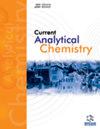A Low-cost and Rapid Method for Determination of Five Flavonoids in Herbal Medicines with Rutin by HPLC-UV at Equal Absorption Wavelength
IF 1.7
4区 化学
Q3 CHEMISTRY, ANALYTICAL
引用次数: 0
Abstract
Background: Flavonoid is a type of active constituent in herbs and always used as the quality control markers of herbal medicines. Owing to the extensive diversity of flavonoids, numerous reference compounds are necessitated for the analysis of flavonoids, and some are usually very expensive, which engenders challenges in the analysis of flavonoids in herbal medicines. Consequently, the development of a simple, rapid, and reference compounds saving method is important for the determination of flavonoids in herbal medicines. Objective: In order to develop a high-performance liquid chromatography (HPLC) method for the determination of 5 flavonoids (mangiferin, hesperidin, baicalin, buddleoside, and rutin) in five herbal medicines (Anemarrhenae rhizome, Sophorae flos, Citri reticulatae pericarpium, Scutellariae radix, and Chrysanthemi indici flos) with rutin. Methods: Five herbal medicine samples were prepared according to the Chinese Pharmacopoeia which includes ultrasound and reflux methods. The separation of the sample was performed on a PoroShell 120 EC-C18 (4.6 mm×100 mm, 2.7 µm) by gradient elution with 0.1% formic acid and acetonitrile at a flow rate of 1.0 mL/min. The wavelengths were set as follows: Anemarrhenae rhizome (363 nm), Sophorae flos (256 nm), Citri reticulatae pericarpium (236 nm), Scutellariae radix (263 nm), Chrysanthemi indici flos (354 nm). Results: The method validation showed that the established HPLC method was accurate and stable for quantitative analysis of flavonoids in five herbal medicines. The comparative analysis revealed that the determination results of the current HPLC method and Chinese Pharmacopoeia method are consistent, exhibiting less than 1% relative error. Remarkably, the developed HPLC method needs one cheapest reference compound (rutin) and costs 8 min for sample HPLC analysis. Conclusion: The developed HPLC method for quantitative analysis of five flavonoids in five herbal medicines is simple, rapid, and reference compound saving, which provides a good alternative method for quality control of flavonoids in herbal medicines.等吸收波长高效液相色谱-紫外法测定中药材中的五种黄酮类化合物和芦丁的低成本快速方法
背景:类黄酮是中草药中的一种活性成分,一直被用作中草药的质量控制指标。由于黄酮类化合物种类繁多,分析黄酮类化合物需要大量的参比化合物,而且有些参比化合物通常非常昂贵,这给中药材中黄酮类化合物的分析带来了挑战。因此,开发一种简单、快速、节省参照化合物的方法对于测定中药材中的黄酮类化合物非常重要。研究目的建立高效液相色谱法(HPLC)测定 5 种中药材(知母、槐花、陈皮、黄芩和菊花)中 5 种黄酮类化合物(芒果苷、橙皮苷、黄芩苷、荆芥苷和芦丁)及芦丁的含量。研究方法根据《中国药典》制备五种中药样品,包括超声法和回流法。样品在 PoroShell 120 EC-C18 (4.6 mm×100 mm, 2.7 µm)上分离,采用 0.1% 甲酸和乙腈梯度洗脱,流速为 1.0 mL/min。波长设置如下茵陈(363 nm)、槐花(256 nm)、陈皮(236 nm)、黄芩(263 nm)、菊花(354 nm)。结果表明方法验证表明,所建立的高效液相色谱法对五种中药材中黄酮类化合物的定量分析准确、稳定。对比分析表明,目前的高效液相色谱法与《中国药典》方法的测定结果一致,相对误差小于 1%。值得注意的是,所开发的高效液相色谱法只需一种最便宜的参比化合物(芦丁),样品的高效液相色谱分析时间为 8 分钟。结论所开发的高效液相色谱法用于定量分析五种中药材中的五种黄酮类化合物,具有简便、快速、节省参比化合物等优点,为中药材中黄酮类化合物的质量控制提供了一种很好的替代方法。
本文章由计算机程序翻译,如有差异,请以英文原文为准。
求助全文
约1分钟内获得全文
求助全文
来源期刊

Current Analytical Chemistry
化学-分析化学
CiteScore
4.10
自引率
0.00%
发文量
90
审稿时长
9 months
期刊介绍:
Current Analytical Chemistry publishes full-length/mini reviews and original research articles on the most recent advances in analytical chemistry. All aspects of the field are represented, including analytical methodology, techniques, and instrumentation in both fundamental and applied research topics of interest to the broad readership of the journal. Current Analytical Chemistry strives to serve as an authoritative source of information in analytical chemistry and in related applications such as biochemical analysis, pharmaceutical research, quantitative biological imaging, novel sensors, and nanotechnology.
 求助内容:
求助内容: 应助结果提醒方式:
应助结果提醒方式:


